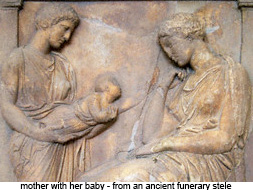August 2009 - Vol. 32 Salt
of the Empire: The Role of the Christian Family in Evangelization,
Misery and Fewer
Girls
Human waste was thrown into open ditches in the middle of the narrow streets, and the cities were smothered in flies attracted by the filth. The corpses of those who died of natural causes were sometimes left to rot in the city’s open sewers. (“The stench of these cities must have been overpowering for many miles – especially in warm weather,” Stark noted.) Water was hard to get and almost always foul. Life expectancy was at most around 30 for men and perhaps much lower for women. Hygiene was minimal. Medical care was more dangerous than disease – and disease often disfigured its victims when it did not kill them. The human body was host to countless parasites, and tenements were infested by vermin. For entertainment, people thronged to the circuses to see other people mutilated and killed. And pagan marriage offered no respite from this misery. Greco-Roman women were usually married off at age 11 or 12, to a mate not of their choosing, who was often much older (Christian girls tended to marry at about 18). Afterward, they suffered in predatory relationships rife with contraception, abortion (which often killed the mother), adultery, and unnatural sexual acts. Infanticide was common, especially for female or defective offspring. Of the 600 families who show up in the records from ancient Delphi, only six raised more than one daughter. Though most of those 600 families were quite large, they had all routinely killed their baby girls. Stark quotes a letter from a pagan businessman writing home to his pregnant wife. After the usual endearments, he closes his letter by saying, briefly and casually, “If you are delivered of a child [before I come home], if it is a boy, keep it, if a girl, discard it.” If fewer girls lived to see the second day from their birth, still more died on their way to adulthood. The shortage of women, then, played further havoc on the population growth of the empire, as well as its economy and its morals. Homosexual activity was considered normal for married men.
Attractive Homes
But Christian marriage and childrearing immediately set Christians apart. According to Stark, Christian husbands and wives genuinely tried to love one another, as their religion required. Their mutual affection and their openness to fertility led to a higher birthrate, and thus to a still higher growth rate for the early Church. They did not abort their children, nor did husbands endanger their wives’ lives by doing so. The early Christians’ respect for the dignity of marriage made the faith enormously attractive to pagan women. So women made up a disproportionate number of the early converts. This in turn made Christianity enormously attractive to pagan men – who could not find many pagan women to marry, but saw young ladies attending the Christian liturgy in great numbers. We should not dismiss these benefits of Christianity in the natural order. One thing that the rise of Christianity demonstrated is that faithfulness to the one true God is the best way to happiness, not only in heaven, but also in the world that God created. Christian faith, then as now, makes for happy homes. And, in pagan cultures, then as now, happy homes are very attractive. The evidence seems to indicate that, in the Roman Empire, Christian homes provided the Church’s primary place of evangelization. And that the Church grew because in every place it lived as a family. This is something we do not find too often in the published lives of the saints, which tend to focus primarily on extraordinary events and great miracles. Nor do we find this story told in ecclesiastical histories, which tend to focus almost exclusively on the lives of the bishops and the clergy. Yet it is the true story of the Church. As St. Augustine put it, the story of the growth of the gospel was the story of “one heart setting another on fire.” The fire of charity tended in the Christian home soon consumed city blocks and then neighborhoods. It was not the sort of ecstatic experience we see in the account of the first Pentecost in the Acts of the Apostles. It was, rather, quiet and gradual. Let us look at just one example of how this fire of charity burned. Epidemics were among the great terrors of life in the ancient world. The physicians in those days knew that the diseases were communicable, but they knew nothing about bacteria or viruses, never mind antibiotics or antisepsis. Once the diseases hit your hometown, there was really no stopping them. Several major epidemics ravaged the empire during the rise of Christianity, and each of them reduced the empire’s population by about one-third.
Copyright © 2004 the Fellowship of St. James. Used with permission.]. . |
. | |
|
(c) copyright 2009 The Sword of the Spirit publishing address: Park Royal Business Centre, 9-17 Park Royal Road, Suite 108, London NW10 7LQ, United Kingdom email: living.bulwark@yahoo.com |
. |

